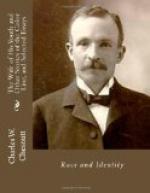Uncle Wellington’s face assumed the ashen hue which does duty for pallor in dusky countenances, and his knees began to tremble. Controlling his voice as well as he could, he replied that he was going up to Jonesboro, the terminus of the railroad, to work for a gentleman at that place. He felt immensely relieved when the conductor pocketed the fare, picked up his lantern, and moved away. It was very unphilosophical and very absurd that a man who was only doing right should feel like a thief, shrink from the sight of other people, and lie instinctively. Fine distinctions were not in uncle Wellington’s line, but he was struck by the unreasonableness of his feelings, and still more by the discomfort they caused him. By and by, however, the motion of the train made him drowsy; his thoughts all ran together in confusion; and he fell asleep with his head on his valise, and one hand in his pocket, clasped tightly around the roll of money.
II
The train from Pittsburg drew into the Union Depot at Groveland, Ohio, one morning in the spring of 187-, with bell ringing and engine puffing; and from a smoking-car emerged the form of uncle Wellington Braboy, a little dusty and travel-stained, and with a sleepy look about his eyes. He mingled in the crowd, and, valise in hand, moved toward the main exit from the depot. There were several tracks to be crossed, and more than once a watchman snatched him out of the way of a baggage-truck, or a train backing into the depot. He at length reached the door, beyond which, and as near as the regulations would permit, stood a number of hackmen, vociferously soliciting patronage. One of them, a colored man, soon secured several passengers. As he closed the door after the last one he turned to uncle Wellington, who stood near him on the sidewalk, looking about irresolutely.
“Is you goin’ uptown?” asked the hackman, as he prepared to mount the box.
“Yas, suh.”
“I ‘ll take you up fo’ a quahtah, ef you want ter git up here an’ ride on de box wid me.”
Uncle Wellington accepted the offer and mounted the box. The hackman whipped up his horses, the carriage climbed the steep hill leading up to the town, and the passengers inside were soon deposited at their hotels.
“Whereabouts do you want to go?” asked the hackman of uncle Wellington, when the carriage was emptied of its last passengers.
“I want ter go ter Brer Sam Williams’s,” said Wellington.
“What ‘s his street an’ number?”
Uncle Wellington did not know the street and number, and the hackman had to explain to him the mystery of numbered houses, to which he was a total stranger.
“Where is he from?” asked the hackman, “and what is his business?”
“He is f’m Norf Ca’lina,” replied uncle Wellington, “an’ makes his livin’ w’itewashin’.”
“I reckon I knows de man,” said the hackman. “I ‘spec’ he ’s changed his name. De man I knows is name’ Johnson. He b’longs ter my chu’ch. I ’m gwine out dat way ter git a passenger fer de ten o’clock train, an I ’ll take you by dere.”




